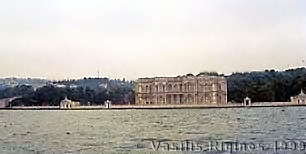This web page contains the logs of S/Y Thetis’ the third leg to the Black Sea. The 5 day leg described in these logs starts from Istanbul and ends in Samsun in the Black Sea. The places that were visited are: Istanbul (Kalamis), Bosphorus, Sile, Amasra, Ovatekkeönü or Ovaköy, Sütlüce or Gideros, and Doganyurt in Paflagonia, and continues West to Sinop, and Samsun. The logs are illustrated with maps and photographs, and also include some historical and geographical descriptions of the places visited as well as several links to other related web sites.
Note: A portion of his passage is also described by my brother Nikos Riginos in his Faneromeni website. Nikos had traveled in the Black Sea in the summer of 1998.
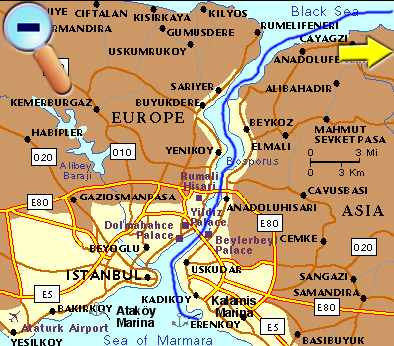
Tuesday July 27, 1999, Day 15
I was woken up at 5:00 by the mosquitoes. But I was too excited to go back to sleep. At last, the much-planned trip to the Black Sea was going to be realized. I slowly started getting Thetis ready. Andonis too, woke up early. When all was ready we cast off and motored to the fuel dock where we tied side-to. It was a narrow spot but we managed without any difficulties. It was staffed and we topped the main tank with 83 L of fuel.
We left Kalamis at 0655, heading for Bosphorus or the Istanbul Bogazi. According to a recent article in the Smithsonian Magazine, the Bosphorus is not only the world’s busiest strait but “the most dangerous.” Indeed the sea traffic was horrific. Until we reached the Bogazi Bridge we were continuously dodging the ferries and other sundry craft. Most seemed to be aware of our presence but at least two simply made a bee line for us and had to be avoided by drastic maneuvering on our part. The detailed chart we bought the day before was a real boon. The current was against us and as strong as advertised. While our speed, read from the log (relative to the water), was 6.5 knots our speed over ground, read from the GPS, was barely 3 knots. The view, however, was incredible. A new surprise at each turn of the “river”: palaces, mansions, gardens, yialis (old Ottoman wooden houses), etc. There was an unexpected amount of greenery. Up on top of a wooded hill we saw the buildings of Robert College (now the Bogazi University) from where many of our teachers at Athens College and several of my Turkish friends in Washington were educated. On we went in this narrow waterway that separates Europe from Asia, staying as close as depth allowed us to the Asian bank. This not only kept us somewhat away from the large ships that were continuously overtaking us but exposed us to a weaker current. Sometimes we gained speed and sometimes we lost, on the average we crept towards the Black Sea. We passed under both bridges, and then Bebek, a famous and plush suburb.
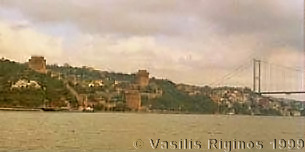
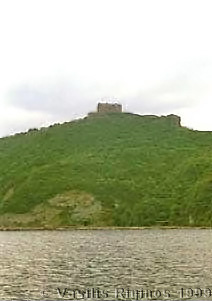
By 1130 we were approaching Poyraz, my intended destination, near the N end of Bosphorus. I had been influenced by the experiences of my brother, Nikos, when last year on on his trip to the Black Sea he experienced horrific waves on exiting the Bosphorus. So my plan called for stopping at Poyraz and entering the Black Sea early in the morning when the waves would be smaller. In the meantime, on Thetis we had a very light 3-6 knots wind from NNE and, although we were at the opening to the Black Sea there were no appreciable waves. I discussed the situation with Andonis, and we decided, since it was still early in the day, to go on into the Black Sea for a few miles and check the conditions. If the conditions were bad we had plenty of time to return to Poyraz.
It was an exhilarating experience to exit from the narrow Bosphorus into the great expanse of the Black Sea. What must the early sailors have felt? After 3 M or so, we did experience a certain swell caused by long, rolling waves but it was not uncomfortable. The wind was a slight breeze of 5-9 knots NNE. We decided to go on to Sile. The sky had been overcast all day but it was not unpleasant. I unrolled the headsail and we were able to sail most of the remaining 22 M to Sile. “There were no dragons”.
In his wonderful book Neal Ascherson describes the unusual conditions of the Black Sea. The Black Sea receives the waters of five major rivers: the Kuban, the Don, the Dnieper, the Dniester, and above all the Danube. These rivers deposit a tremendous amount of organic matter. Over thousands of years the bacteria feeding on this matter exhausted the oxygen at the lower depths of the Black Sea, creating a condition known as anoxia. In its stead, the oxygen has been replaced by the deadly hydrogen sulfide (H₂S). So, today the Black Sea consists of two layers separated by a well-defined boundary called haloclyne or oxyclyne. This boundary is at a depth of about 200 m, below which the water is infused by H₂S and is totally devoid of life. Above the oxyclyne however, the surface layer of the Black Sea is teaming with life and fish. This abundance of fish has made the coastal area very wealthy. The Black Sea basin was colonized by the Greeks as early as the Bronze age. The legend of the Argonauts in search for the Golden Fleece originates from that period. Mycenaean anchors have been found all along the coast of the Black Sea. Later in the antiquity many Greek coastal colonies had been established around the sea trading with their founding mother cities dried fish and later wheat and timber. The Greek presence in the Black Sea, or the Pontos, continued until the early part of this century.
Recent theories have linked the formation of the Black Sea with the biblical legend of the Flood. According to these theories the Black Sea was originally a fresh water lake. Then, 7,600 years ago, the melting of the glaciers flooded the Mediterranean. This extra water, eventually cut a narrow channel, the Bosphorus, and salt water flowed into the Black Sea at the rate of 10 cubic miles per day for two years. This deluge caused the waters in the Black Sea to rise at the rate of six inches per day (15 cm) and covered all the coastal human habitations. Robert D. Ballard, the discoverer of the Titanic, is leading an expedition, based in Sinope, to investigate this theory. The Institute of Nautical Archaeology, under the leadershp of the pioneering underwater archaeologist George Bass, is also interested in future work in the Black Sea waters.
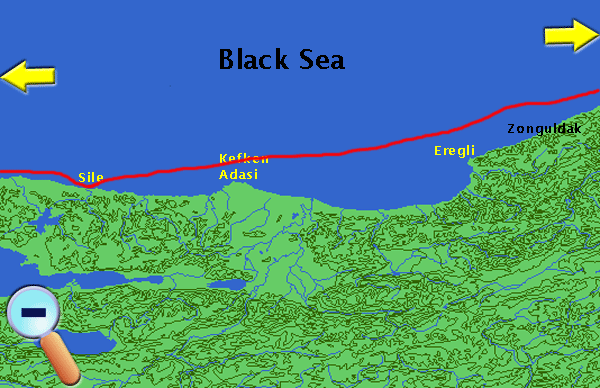
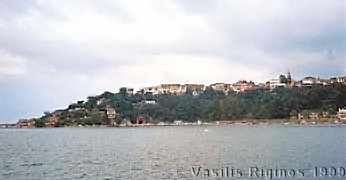
We arrived in Sile [41° 11' N, 029° 36' E] at 1455, our total distance from Kalamis was 44.4 M. We anchored outside the harbor at 5 m, partially sheltered from the swell by the jetty. We actually had arrived in the Black Sea. We put up the tent, since by now there was some sunshine. The water temperature was an amazingly warm 27°C (81°F), its color was greenish. We put on our bathing suits and had our first Black Sea swim. The water was definitely not clear. I dove to the bottom, I could touch it but I could not see it. It was sand. Andonis, who was observing me from the cockpit could not see my body.
By late afternoon the swell had increased to an uncomfortable level. We took down the tent, pulled up the anchor, and entered the harbor but we did not dock; we anchored just to the right of the W jetty in 6 m of water. Here it was very calm and comfortable. The wind continued to be very light. We were the only non-fishing boat in the harbor. We prepared the zodiac and went ashore.
The town is up the hill along a palisade and is a very attractive, low key resort. We had dinner at the Baliki restaurant near the NE side of the town. The owner is from Xanthi, Greece and speaks very good Greek. Both he and his son were very polite and sat us on the deck over the palisade which affords a spectacular view. We were served an assortment of mezedes for appetizer which was followed with grilled fish a tsipur (τσιπούρα - porgy) and a lavrak (λαβράκι - striped bass). They were delicious along with the chilled white Kavildere wine. Our first evening in the Black Sea had begun very auspiciously. As we were congratulating ourselves and enjoying the food and the view, watching a small sail boat entering the harbor, we heard the roaring sound of a nearby thunder. We looked up and sure enough black cumulus-nimbus clouds were rolling in from the S. It started to rain. As we were debating whether we had closed the hatches or left them open, it started to rain in earnest. We moved indoors and finished our meal in a hurry. By that time, it was a downpour with a spectacular display of lightning and thunders, all very close. We bought some bottles of spring water and ran down hill, we got into the zodiac, and motored to Thetis. Although the hatch over Andonis’ cabin was open, surprisingly little water had entered onto his berth. After an hour the rain was over and the black clouds had moved N, out to sea.
The little sailing boat that we had observed entering the harbor was now rafted side-to along a fishing boat. We looked at her with the binoculars and recognized her as the French boat with a middle aged couple that was not too far from us in Kalamis. As it was late, we did not go ashore again and we did not speak to them.
Our plan was to head tomorrow for Amasra and sail there non-stop if possible. Now, last year, my brother Nikos was here in Sile and, in addition to very rough seas, had the following problem. As soon as he left Sile heading for Amasra the Faneromeni was intercepted by a Turkish patrol boat. They herded him back to the harbor because a wide area E of Sile was closed to navigation due to a firing practice by the Turkish Air Force. So, I have been watching the Navtex for any such notice to mariners. Sure enough it did give warning and coordinates for a firing practice tomorrow, but to our great relief, it was scheduled not E of Sile but W, right where we had just come from. The weather forecast was also favorable: 2-4 occasionally 5 NE. With this encouraging news we called it a night.
Wednesday July 28, 1999, Day 16
We started preparing early for the long sail of about 130 M. During the night a small sailing boat had come into the harbor and anchored not too far from us. It flew what looked like a Dutch flag. Around 0800 we started raising our anchor. There was no problem other than the chain, which was completely coated by a thin green weed the consistency of cotton candy (μαλιά της γριάς) or cataif (καταΐφι - a middle eastern pastry). It covered over 30 m of chain and it was sticky. It took us over half an hour to raise the anchor while cleaning the chain. After we were free, and before leaving the harbor, we swung over to inspect the “Dutch” vessel. It was not Dutch but Russian. There were three men aboard. They asked Andonis, who was at the bow, if we were going to Istanbul. He said, “no, we are coming from Istanbul, have you come from Amasra?” “Yes.” “Did you have rough seas?” “Yes.” “Did you come from Odessa?” “Yes.” “Did you have good weather?” “Yes.” We gave up, and left the harbor.
The time we left Sile was 0820. There were large waves. Andonis and I got into an argument about wave height. He estimated 2-5 m while I estimated ½ - 1 m. The wind was 10-14 knots NNW. After setting our course for Amasra, to our delight, this wind allowed us to sail. We raised the main, shaking off its reef (which I had set way back at Kea), unfurled the genoa, and turned off the motor. While raising the main, one of its lazy jack lines came undone. There was no way of retrieving it without climbing up the mast. I chose to ignore it for the time being since it was definitely a non-critical item. Other then that, the sail was very good. We made good speed despite the large waves. They were long swell-like, not choppy. Thetis handled them beautifully.
By noon we were still sailing. It was not too uncomfortable, but Andonis was beginning to feel the effect of the swell. I had been a little apprehensive about him because he has never before been that far offshore and we had a long distance to go. As the afternoon progressed the wind increased to 18 knots and the waves grew. By the early evening we had more than 20 knots of wind and I reduced the headsail by a third. Andonis all this time had been getting worse despite my assurances that he would soon get his sea legs. He did not feel like eating, but I did convince him to take some solid food. I secretly started thinking that if he deteriorates we will go closer ashore and stop at some harbor, rather then have him suffer. Since we left Sile we had only seen a ketch at a distance and a patrol boat. No other traffic.
Around 2100 the wind died out. We lowered the main, which was flapping, rolled in the headsail, and started the motor. The red navigation light did not work. Fortunately there was zero traffic. Andonis was already feeling much better and my apprehensions were eased. We had an ouzo and I cooked some rice with a sauce made of tuna fish sautéed with onions, capers, and balsamic vinegar. It was barely calm enough for us to set the table and eat out in the cockpit. It was a pleasant and peaceful night except for the noise from our motor.
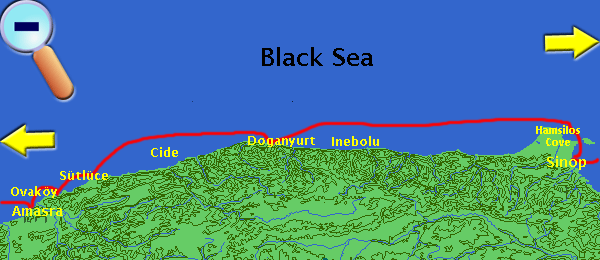
Thursday July 29, 1999, Day 17
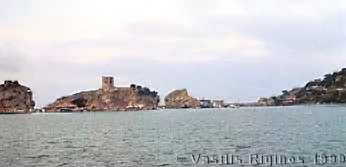
Around midnight, the wind returned at 12-18 knots SSE. Once again, we opened the genoa and turned off the motor. Bliss! We even played music on the CD player. We started short watches, of sorts, of one hour each: one of us watching while the other was dozing. On the one hand, I did not want Andonis to feel any pressure as I was not too sure about his condition, but on the other I did not want to give him the impression that I did not trust him. We encountered a ship, about 1.5 M at its closest approach going in the opposite direction. Thus the night and early morning hours progressed nicely while making good headway. The 2 knots current was pushing us towards our destination. By this time Andonis, not only had completely recovered from the symptoms of the mal de mere, but was beginning to actually enjoy himself, appreciating the beauty of a fast night sail.
We entered the harbor of Amasra, the Greek Άμαστρις - Amastris [41° 44.9' N, 032° 24' E] at 0530 at sunrise. The log indicated 112.3 M but the actual distance as measured on the chart was 131 M. The difference was due to the favorable current of about 1.8 knots.
Amasra or Amastris was founded at the site of Sesamus which was a colony established by Milesians in the 6th century BC although Sesamus could be even earlier as it is referred to by Homer in the Iliad (Book II). According to Starbo, Amastris was founded in the 3rd century BC by queen Amastris or Amestris of Heracleia Pontica (modern Eregli). She was the niece of Darius III who was defeated by Alexander the Great. She first married Craterus (a Macedonian and close friend of Alexander) and learned Greek. After Craterus died she married Dionysios the tyrant of Heracleia Pontica. Dionysios soon died also and she ruled as a Greek queen in the name of her son. Amastris was murdered by her sons in 288 BC and the city soon came under the rule of Eumenes of Tieum, brother of Philetaerus of Pergamon. Eumenes lost the city to Ariobarzanes, king of Pontus. During the Roman period, Amastris was occupied by Lucullus and became part of the Roman province of Asia. In the Byzantine era, Amastris declined. In 1214 Amastris, along with many other towns, was seized from David Comnenos by Theodore Laskaris. After the fall of the Byzantine empire Amastris was occupied by the Genoese who held the city until it was conquered by the Ottomans around 1460 AD who renamed it Amasra.
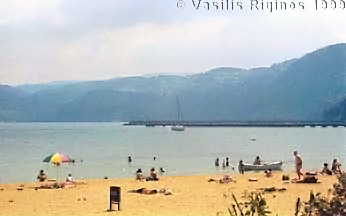
The harbor was large and I decided to anchor off-shore and not to dock near the fishing boats that usually have an unpleasant odor. Also, the area where we could dock had strong illumination and we would not be too comfortable at night. We had some difficulties anchoring. To begin with, the starter did not turn the engine. I had to use the override switch to connect the service batteries to the starter. This was mystifying because all the batteries were new and there have been no indications of trouble with either the alternator or the regulator. We dropped the anchor at 6 m. The water was very calm, although murky, but there were some fierce gusts from the S. The anchor did not hold, despite the long scope, and we drifted towards other moored boats. While Andonis was holding the tiller, I started raising the anchor. It was totally fouled with an old net. There were no markers or buoys to indicate the presence of nets within the harbor. There was no way for me to disentangle our anchor from these nets before we would collide with another boat. Having no choice, I reluctantly cut the nets with a knife just in time to avoid the collision. We tried anchoring again. The anchor held for a while, but when we tested it by reversing the motor, it came loose. It was covered with weeds. Frustrated, we moved to another spot and tried again. This time we were successful. Andonis was agitated and we were both tired, but we were safe.
Although all I wanted to do was to crawl into my berth, I decided that we must first attend to our problems. I got out the bosun’s chair and Andonis hoisted me up the mast where I retrieved the errant lazy-jack line. Then we both looked at the navigation lights. The contacts were off. As usual, the connections were not of marine quality but for household use and had thoroughly corroded. True to the habits of electricians the world over, ours had left no slack cable to allow for the replacement of the contacts. The cable had to be extended with a splice. A further aggravation was that due to the wind the small butane soldering iron did not get hot enough to allow me to solder the splice. I had to be content to twist the wires together and cover them with insulating tape. At least now both navigational lights worked.
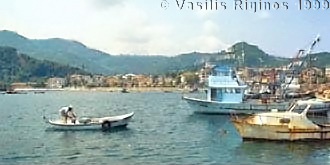
While doing these repairs, I spotted an old fisherman in a small row boat, approaching us. He dropped a hooked line (σαλαγγειά) and dragged it until it caught his nets. He then started hauling them. I told Andonis not to seem to pay too much attention to the fisherman but to continue with our repairs. I was absolutely convinced that either somebody had seen us cutting the nets and reported it to him or he would immediately suspect the Greek boat. I could just see in my mind’s eye us being boarded by the authorities and charged with the destruction of property, and having to pay an exorbitant compensation for the rotting nets. As a precaution, we nonchalantly rolled-in our Greek flag.
Not being sure of how secure our anchor was, I put on my bathing suit and dived with a mask to check it. The low visibility made this task very difficult. I had to follow the chain all the way to the anchor to determine that the anchor was buried in the sand and not in weed by feel alone. Here, as everywhere else since we entered the Black Sea, the water is turbid and has a dirty oil-green color. A far cry from the deep blue Aegean.
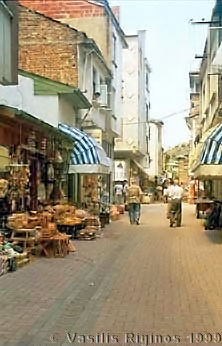
After a short rest, we launched the zodiac and went ashore where we took a short walk and bought some bread and bottled water. The town seemed attractive although somewhat run down. When we returned back on board, the fisherman was still hauling his nets. We were too exhausted even to worry. We had a snack, and fell asleep for several hours under the tent.
After we woke up and had a restorative coffee I started investigating the problem with our starting battery. Its voltage was indeed low. I started the motor with the service battery and observed the charging voltage. The service battery was being charged with about 0.5 V lower than it should. I used the override switch and paralleled the batteries; now the charging voltage was fine. It looked that the voltage drop was across the electronic paralleling switch. I cleaned its contacts. Now it seemed OK. We shall see. Next I occupied myself with receiving e-mail via the GSM phone. In the past few days we had some difficulty connecting to the provider in Athens. Nikos, who was in Corfu with the Faneromeni, told me with SMS messages that he too has had similar problems. It seems that the trouble was within OTE, the Greek telephone company. At any rate, we did manage to get the e-mail. Maybe the problems were fixed.
Here I want to say a word about SMS (Short Message Service). It is a standard of GSM (Global System for Mobile communications) which is the cellular system used in Europe and Asia. It allows a telephone to send a short, 160 character, text message to any other phone on the system. Something like short e-mail. The difference is that it is not via the Internet but via the cellular telephone system. If your responder’s phone is on, they get your message in real time. If it is off, they get it as soon as they switch their phone on. It costs a fraction of the cost for voice and is much less disruptive.
Nikos had informed me, with SMS, that his friend Hüseyn Çoban lives in Amasra. Çoban owns a shipyard that specializes in building wooden boats near Amasra. He and his wife had joined Nikos on the Faneromeni last year on his Black Sea trip from Istanbul to Amasra. So, as soon as we landed ashore with the zodiac, I was going to ask about him. Very near to our landing there was a boat-house from which young kids were sailing in groups with small dinghies. It seemed that this would be a natural place to start our inquiries. The first person we met there we asked if he knew a Mr. Hüseyn Çoban who owns a shipyard. With a very bewildered look he answered that he himself was Hüseyn Çoban. What a coincidence! His English was slow but he seemed glad to meet Nikos’ brother. He gave us the coordinates of his shipyard, which is some 15 M E of Amasra and invited us to visit him tomorrow at about 12:00.
We walked around the town and did some shopping. After we left our groceries in the zodiac we went to eat at the Çesme Cishavik restaurant. It has a terrace overlooking the harbor. The waiter told us that his name was “Elvis Presly.” He brought a platter with raw fresh fish for us to choose. We took a sample of Black Sea fish: hamsi (χαμψί), a kind of sardine indigenous to the Black Sea, kalkan (καλκάνι) a kind of ray fish, and barboun a red mullet. We ordered several of these since they were not too big, together with the specialty of the house, çoban salat, shepherd’s salad, and a bottle of white Kavildere wine. We ate these with great relish, enjoying the view of the harbor with Thetis in the middle. For dessert, we ordered a fruit plate. “Elvis” brought us a large platter with an artistic arrangement of watermelon, grapes, melon, peaches, and pears. All were very good except for the melon which was not very tasty. When “Elvis” asked us how everything was, Andonis pointed this out. “Elvis,” immediately apologized and brought us another plate with slices of a really wonderful melon.
Sated, we made our way back to the zodiac and then to Thetis for a good night’s sleep.
Friday July 30, 1999, Day 18
In last year’s trip Nikos, with the Faneromeni, got as far as Amasra. Now Thetis was ready to leave Amasra and get deeper into the Black Sea, but we had to be back in Istanbul by August 14, when Jane Ephremides and my daughter Corinna were due. Obviously we could not go too far and run the risk of being late back in Istanbul. We also wanted to make sure that we would have time enough to do some land exploration. In particular, we were determined not to miss the famous Byzantine Monastery of Sumela, located inland from Trabzon. This translated into finding a secure place where we could leave Thetis unattended, rent a car, and go on a land expedition for a few days. According to our reading of the Black Sea Cruising Guide, and our conversations yesterday with Çoban, it seemed that Sinop would be a good place to do so. Thus, our plan was to sail up to Ovatekkeönü where Çoban’s shipyard is, visit with him for a few hours, and then sail overnight to Sinop.
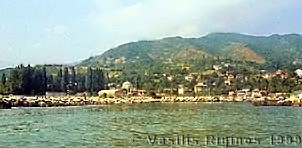
Before leaving in the morning, I did manage to both send and receive e-mails with the GSM phone. By 0820 we had raised the anchor and were exiting the harbor of Amasra. There was no wind, but fairly large swell. The coast of Paflagonia is very green with large and steep mountains. A very dramatic and beautiful scenery, but too hazy to take good pictures. We motored to Ovatekkeönü or Ovaköy [41° 50' N, 032° 40.3' E] where we planned to visit Çoban, but the little harbor was not large and deep enough for Thetis to anchor, while outside the harbor the swell was definitely too large for us to wait until 12:00. I tried to call Çoban on the GSM but did not find him. So, reluctantly we moved on to Sütlüce or Gideros [41° 51.8' N, 032° 51.5' E] where we arrived at 1110. This is the cove where the modern Argonauts, described by Tim Severin in the Jason Voyage, were holed-in by a gale is indeed lovely. A jewel of a small cove surrounded by tall peaks covered with clouds. Alas the water was an opaque green color, covered with an oil slick, and garbage. We anchored without any problem but we had no desire to swim in this water. We just had a snack under the tent and then left.
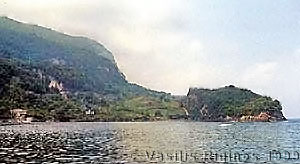
The Cove |
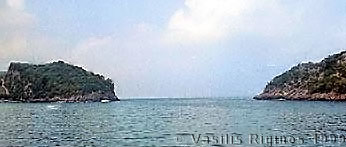
The Entrance to the Cove |
We left Sütlüce at 1150 heading towards Sinop. As at this rate, helped by the current, we would arrive at Sinop sometimes in the middle of the night, we decided to slow down and stop in another place for a few hours. Still motoring, we arrived at Doganyurt [42° 0.5' N, 033° 27.6' E] at 1625, having covered 25.5 M from Amasra. It is an attractive harbor, not very busy. We anchored off-shore at 6 m. The bottom is mud and affords very good holding. The water was not too bad and we did swim this time. We really had to lower our Aegean standards as to water quality suitable for swimming. A rowboat full of children, boys and girls, came near Thetis and engaged us in conversation. The conversation was conducted in school English. They did not recognize our flag and asked us where we came from. Greece did not seem to ring a bell, but when we said “Yunanistan” (Turkish for “Greece”) there was recognition. We asked them if they wanted to come aboard and see Thetis. One boy and one girl were very curious and keen to climb aboard but an older boy said a few words to them and made them change their minds.
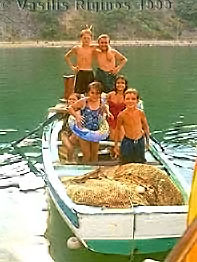
We launched the zodiac and went ashore. It is a very rustic village but has several stores, including electrical and plumbing equipment. Friday is a market day here. It was a wonderful fruit market, and we bought several fruits. Back aboard we were visited once again by the same rowboat but now populated by older youths. One of them asked us for a cigarette and seemed very disappointed and incredulous when we said that we had none. He then asked for matches. We produced a box of Greek matches. As they came to get them, they rammed Thetis. That did not seem to upset them at all. One of them knew some English. He was crew in a freighter and has been to Piraeus. He loves ouzo he said. We did not rise to the bait.
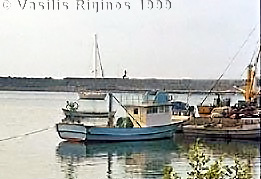
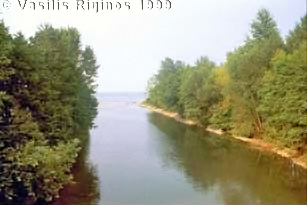
The River |
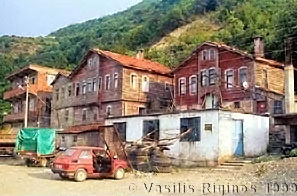
Houses |
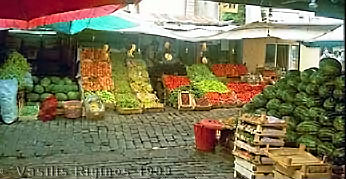
The Market |
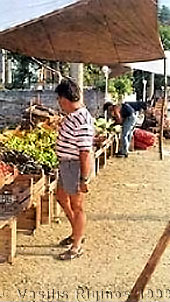
Andonis Shopping |
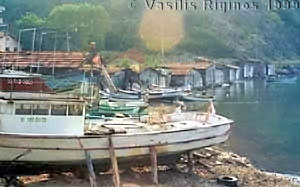
|
|
While still at anchor, I started cooking some pasta with a puttanesca sauce. I prepared all the ingredients for the sauce. I made a salad, and put the water for the pasta to boil. While the water was heating we raised the anchor, turned on our navigation lights, and left the harbor of Doganyurt. The time was 2005. While the pasta was boiling, I lashed the zodiac on the deck. The sea was fairly calm, the swell was considerably less than during the day but still no wind for sailing. We motored. We set up the table in the cockpit and ate the pasta with a nice red Turkish wine. It was a lovely night. When we were abeam of Inebolu, the moon started rising over the mountains. A large orange orb. A fireworks display was going on at the distant Inebolu. What more can one ask for entertainment! Most of the day we did not have a signal on the GSM phone. Now, the signal came back but I still did not find Çoban. We had voice mail however. One message was for Andonis from his mother who wanted to know how he was. The second was from a lady journalist, a friend of Turgut Ayker who wanted to know when we would be back in Istanbul to interview me. I had a very hard time getting her name and phone number, however. The problem will have to wait for tomorrow anyway, since by now it was past 10:00 PM. We started a watch system. Andonis took the first watch, 11 to 1, and I went to my cabin to sleep.
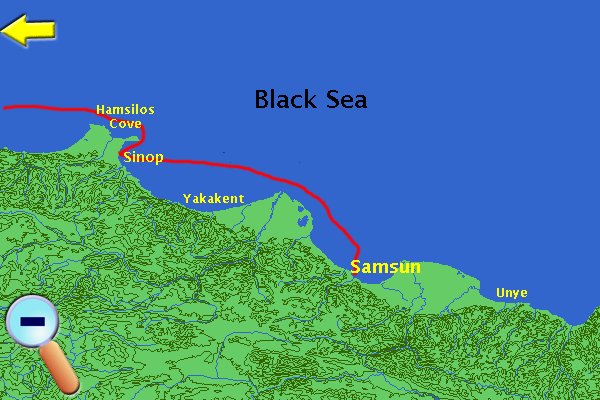
Saturday July 31, 1999, Day 19

During the early morning hours there were two times when there was a hint of wind, and because Andonis was very keen on sailing, I opened the genoa. Once, we even sailed for all of ten minutes. After rounding Ince Burun we saw a school of dolphins. One dolphin came very close to our stern, eyed us all over and then went away. I have never seen this behavior before. Usually when dolphins approach a sailboat they play with the bow wave. Despite all the fishing boats that we have been seeing in the harbors we have hardly seen another boat since Sile and none since Amasra.
As we had been motoring and the fuel in the tank had been running low, I asked Andonis, during the change of watch at 0300, to help me siphon fuel from one of the 20 L jerry cans. Other than that, our night passage was totally uneventful.
Our approach to Sinop, after day break, afforded us impressive sights of the Sinop peninsula. Around 0800 I called my mother in Athens and Andonis called his. We rounded the peninsula, and by 0900 we were entering the harbor [42° 01.3' N 35° 08.5' E]. Our sea miles from Doganyurt were 77.6 M.
Traces of human habitation near Sinop have been dated as far back as the 4,500 BC and there were Bronze Age settlements here dating from 3,000 to 2,700 BC and of the early Hittite period of 1,800 BC. During the 8th century BC colonists from Miletus established a trading post here and named it Sinope (Σινώπη) after the daughter of a river god. Sinope in turn established new colonies: Cotyora (Ordu), Cerasus (Giresun), and Trapezus (Trabzon). The cynic philosopher Diogenes (400-323 BC) was borne here and later moved to Athens after his father was accused of adulterating coins. Sinope was where in 399 BC Xenophon and the 10,000 first sighted the sea after a long march from Persia and exclaimed: “Θάλαττα, θάλαττα” (the sea, the sea). In 375 BC Sinope was conquered for a while by Datames the satrap of Cappadocia and then fell under the Persians. In 333 BC it became part of the Macedonian kingdom of Alexander the Great. Mithridates III and his son Pharmaces I took Sinope in 183 BC and made it the capital of their kingdom of Pontus. This kingdom was overtaken by the Roman general Lucullus in 68 BC and Sinope was declared part of Rome by Pompey in 63 BC. In the Byzantine period, Sinope declined but in the first half of the 6th century AD had a revival under Justinian, who built castles, aqueducts, bridges, and churches. It was taken from the Byzantines by emir Karatekin in 1084 and formed an emirate together with Kastamonu and Çankin but was later recaptured by the Byzantines. During the fourth crusade when the crusaders sacked Constantinople in 1204, Sinope came under the rule of the emperor of Trapezun Alexios I Comnenos. During this time the Genoese established here a trading post under an agreement with the Comneni. In 1124 the city was captured by the Selcuks but was retaken in 1254 by Manuel I Comnenos and was held until 1265 when again it fell to the Selcuks. In 1324 the city was captured by the Turkomans and renamed Sinop. They held it until 1461 when the Ottomans captured it under Mehmet II. In 1853 the city was bombarded by Russian ships and badly damaged. This incident precipitated the Crimean War.
The harbor was crowded with large, steel fishing boats and did not look particularly inviting. There was no room for Thetis to dock, neither side-to or stern-to. The only way we could dock was to raft. Nor was there an option to anchor off-shore. Under these conditions I could not possibly leave Thetis unattended for days. This development totally derailed our plans. We had two choices: raft temporarily and see if better arrangement could be made later in the day, or push on for another 75 M to Samsun. Here we did have the knowledge from Çoban that a car rental was feasible. He even said that he had a friend who could help us. But, if we delayed we may lose a precious day. So we decided to go on.
We left Sinop at 0918. After setting a direct course for Bafra Burnu, we siphoned another 25 L from one of the large jerry cans. This took some time. After this messy job, and while we still had a GSM signal, I tried to call the lady journalist who had left me voice mail. It seems that I had transcribed the wrong number. I called Turgut. Yes, he did know all about her and he gave me her husband’s number which I called and left a voice mail message. The current, which up to this point had been favorable, increasing our ground speed by 1- 1.5 knots, was by now considerably weaker. Our actual ground speed was about 6 knots. Still no wind. At this rate we were not going to make to Samsun before nightfall. τί να κάνουμε; What can we do?
On, and on, we motored. At least we had the tent as it was quite hot. We had also been plagued since yesterday by an infestation of flies. It was a mystery where they had come from. They were small and did not move very much. Both of us were continuously swatting them, but they seemed inexhaustible. Andonis, despite the setback, was in a good mood. On we went. All day motoring, being hot, and dealing with flies.
By the time we were approaching Samsun [41° 18' N, 036° 21' E], it was, as predicted, getting dark. No wind but a heavy ominous cloud was lurking some distance out at sea to the N of us, treating us to a display of spectacular lightning. We did not have much difficulty in finding the harbor entrance in the dark as it was well marked by red and green flashing beacons. We entered the harbor at 2105, our total distance from Amasra was 150.2 M.
Following the instructions of the Black Sea Cruising Guide, we proceeded in the mile long harbor looking for the “Yacht Club” somewhere ⅔ M on the S side. The harbor had a number of large cargo ships being unloaded by the cranes on the N jetty. It was also incredibly dirty. The air was permeated with the smell of untreated sewage. Although both pairs of our eyes kept looking we saw nothing resembling a “Yacht Club.” Thus we finally reached the E end of the harbor where the water was getting shallow. I figured that it would be best if I anchored temporarily there, where we were at least away from harbor traffic, and then went exploring for a better spot with the zodiac. So we anchored at 6 m, the anchor held well, and while we were secured for the time being we would be in trouble if the wind were to shift from the NW. I guess that we were both tired because our communications broke down completely. On my part, I failed to tell Andonis what I was planning to do. On his part, he failed to perceive that we were very far from finishing. While I started to untie and launch the zodiac, he proceeded to take a hot shower declaring that he was too tired to do go ashore. This really annoyed me. I took our trash and stepped in the zodiac. I was also extremely hungry.
While driving the zodiac, slowly by the S shore, I kept looking for a likely candidate or for the elusive “Yacht Club.” According to the description, it had a restaurant and it was near a dance club. The shore was full of lights and people. There was loud music coming from many directions. Every so often, a large fish would splash in the filthy water. The smell was unbearable. After going up and down the shore a few times, I decided that the most likely candidate was a wooden shack next to a restaurant on a floating barge. East of the barge was a large building, decorated with strobe lights, which was emitting some very loud music. Next to the shack was a rough concrete landing. I went there. There were 3-4 men by the shack. An old man came and helped me tie the painter. As I stepped ashore I saw that inside the shack was a bed and a table which could have been used as an office. I tried to explain to the men that I was looking for the “Yacht Club” but they did not seem to understand me. I took the trash, and looked for a trash bin. It looked as if there was a carnival, with lots, and lots of people milling around. There were many eateries, fast food, carousels, and ice cream parlors. It was a most surrealistic impression, again I supposed because I was very tired and hungry. I went into the floating restaurant, adjacent to my candidate for the “Yacht Club,” where I had a grilled trout (alabalik) and a beer. Feeling much better, I went back to the “office” and tried once more to explain myself. My suspicions, on it being the “Yacht Club” were reinforced since I saw a man inside talking to a VHF. On an inspiration, I took out one of Thetis’ calling cards that has the picture of a sailboat, and showed it to him. His face lit up, and he exclaimed: “Kotér!” pointing towards Thetis. Now in old nautical Greek a yacht is sometimes refereed to as a κότερο i.e. a cutter. Instant communication! Yes, I did come from the kotér. I made hand signs of anchoring. He indicated to me that where Thetis was was not good. I tried to inquire where it would be good. He indicated that he wanted to get into the zodiac and show me. We introduced ourselves. I pointed to myself and said “Vasilis,” yes he got that; “Vasile.” He pointed to himself “Ergin.”
We both got into the zodiac. From the way he moved it was clear that he was comfortable in boats. As we were approaching Thetis, I started calling Andonis. I was still very cross at him, yet I did not want him to be caught unawares that we were having a visitor. He was in the bathroom shaving. As we were climbing up the ladder, he appeared. We both made the best of a tense situation. I tried to ask Ergin if we needed any docking lines. He asked how much depth we were drawing. I told him 2.5 m. He indicated that we were going to moor off-shore and no lines were needed. I started the engine, and Andonis went to the bow with Ergin to raise the anchor. The filthy mud that came aboard with the chain was beyond description. Neither Andonis nor I were going to touch it, if we could help it. We left the anchor dangling while we motored very slowly to where Ergin was pointing. Andonis understood that we would be catching a permanent mooring and he got the hook. We slowly crept near to the “office” and very close to the shore. My eyes were glued to the depth sounder. The mooring, although close to shore was at a comfortable 5 m depth. Andonis caught its line with the hook, and as luck would have it, Ergin, secured it to our bow cleat, thus sparing Andonis physical contact with the foul rope. We were now securely moored.
Ergin, hung around and we made small talk. He was a fascinating character and despite our exhaustion we enjoyed getting to know him. It seems that he had been a fisherman specializing in catching sea snails - “saliangos.” He understood that we needed fuel and that we wanted to leave the boat at the harbor for a few days. I gave him two small bottles of ouzo which he first refused to accept, but when we explained that they came from “my” island in Greece, Samos he took them. At last, I ferried him ashore. He said that he would be back at around 9:00 in the morning. Back aboard we both fell asleep despite the bad smell.
This is the furthest point East that we would go with Thetis and the furthest East that she had ever been.
The total distance we traveled from Istanbul to Samsun was 307 M and 68.25 travel hours.
